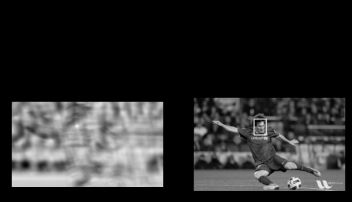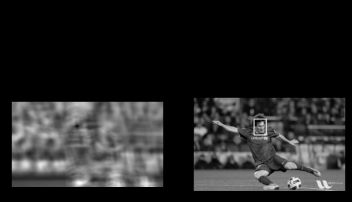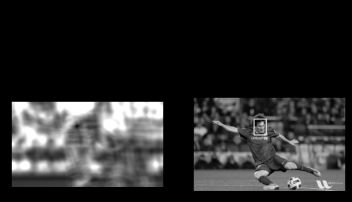目标
在本章中,您将学习 - 使用模板匹配在图像中查找对象 - 你将看到以下功能:cv.matchTemplate(),cv.minMaxLoc()
理论
模板匹配是一种用于在较大图像中搜索和查找模板图像位置的方法。为此,OpenCV带有一个函数**cv.matchTemplate**()。 它只是将模板图像滑动到输入图像上(就像在2D卷积中一样),然后在模板图像下比较模板和输入图像的拼图。 OpenCV中实现了几种比较方法。(您可以检查文档以了解更多详细信息)。它返回一个灰度图像,其中每个像素表示该像素的邻域与模板匹配的程度。
如果输入图像的大小为(WxH),而模板图像的大小为(wxh),则输出图像的大小将为(W-w + 1,H-h + 1)。得到结果后,可以使用**cv.minMaxLoc**()函数查找最大/最小值在哪。将其作为矩形的左上角,并以(w,h)作为矩形的宽度和高度。该矩形是您模板的区域。
注意 如果使用**cv.TM_SQDIFF**作为比较方法,则最小值提供最佳匹配。
OpenCV中的模板匹配
作为示例,我们将在梅西的照片中搜索他的脸。所以我创建了一个模板,如下所示: ![]() 我们将尝试所有比较方法,以便我们可以看到它们的结果如何:
我们将尝试所有比较方法,以便我们可以看到它们的结果如何:
import cv2 as cv import numpy as np from matplotlib import pyplot as plt img = cv.imread('梅西.jpg',0) img2 = img.copy() template = cv.imread('模板.jpg',0) w, h = template.shape[::-1] # 列表中所有的6种比较方法 methods = ['cv.TM_CCOEFF', 'cv.TM_CCOEFF_NORMED', 'cv.TM_CCORR', 'cv.TM_CCORR_NORMED', 'cv.TM_SQDIFF', 'cv.TM_SQDIFF_NORMED'] for meth in methods: img = img2.copy() method = eval(meth) # 应用模板匹配 res = cv.matchTemplate(img,template,method) min_val, max_val, min_loc, max_loc = cv.minMaxLoc(res) # 如果方法是TM_SQDIFF或TM_SQDIFF_NORMED,则取最小值 if method in [cv.TM_SQDIFF, cv.TM_SQDIFF_NORMED]: top_left = min_loc else: top_left = max_loc bottom_right = (top_left[0] + w, top_left[1] + h) cv.rectangle(img,top_left, bottom_right, 255, 2) plt.subplot(121),plt.imshow(res,cmap = 'gray') plt.title('Matching Result'), plt.xticks([]), plt.yticks([]) plt.subplot(122),plt.imshow(img,cmap = 'gray') plt.title('Detected Point'), plt.xticks([]), plt.yticks([]) plt.suptitle(meth) plt.show()
您会看到,使用**cv.TM_CCORR**的结果并不理想。
多对象的模板匹配
在上一节中,我们在图像中搜索了梅西的脸,该脸在图像中仅出现一次。假设您正在搜索具有多次出现的对象,则**cv.minMaxLoc**()不会为您提供所有位置。在这种情况下,我们将使用阈值化。因此,在此示例中,我们将使用著名游戏**Mario**的屏幕截图,并在其中找到硬币。
import cv2 as cv import numpy as np from matplotlib import pyplot as plt img_rgb = cv.imread('mario.png') img_gray = cv.cvtColor(img_rgb, cv.COLOR_BGR2GRAY) template = cv.imread('mario_coin.png',0) w, h = template.shape[::-1] res = cv.matchTemplate(img_gray,template,cv.TM_CCOEFF_NORMED) threshold = 0.8 loc = np.where( res >= threshold) for pt in zip(*loc[::-1]): cv.rectangle(img_rgb, pt, (pt[0] + w, pt[1] + h), (0,0,255), 2) cv.imwrite('res.png',img_rgb)
参考:http://woshicver.com/FifthSection/4_12_%E6%A8%A1%E6%9D%BF%E5%8C%B9%E9%85%8D/






